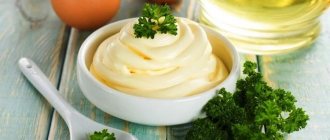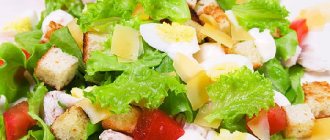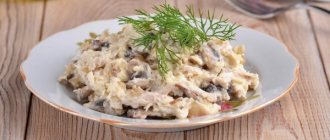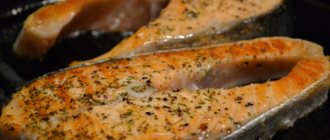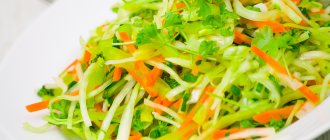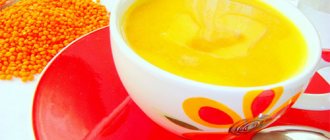Tamago no mono sounds like a song. Far away and beautiful, like Japan itself. What does she want to tell us? You won't believe it, but this song is about mayonnaise. Tamago-no-mono or Japanese mayonnaise, what is it and what are the notes-ingredients of this melody?
Let's start from afar, with the fact that everything unknown attracts and attracts us. With what greed and passion the Russian people began to try Japanese rolls and sushi! It’s amazing how seemingly simple ingredients sparkle with new colors and, thanks to a clever combination, become a unique and inimitable dish. Japanese mayonnaise also boasts such characteristics. Undoubtedly, once you have tasted its exquisite, refined taste, and felt its pleasant tenderness on your tongue, you will certainly cook it again and again, delighting your loved ones and welcoming guests.
Ingredients
Let’s say right away that not all ingredients for Japanese mayonnaise are easily available. Each of them, of course, can be bought in Russia, but not every city can boast of a variety of products for making rolls. Nevertheless, we will list what is needed according to the traditional recipe, and then slightly adapt these products to Russian reality:
- soybean oil – 1 cup or 230 ml;
- eggs – 3 pcs.;
- rice vinegar – 1 tsp;
- white miso paste – 50 g;
- yuzu lemon – 1 pc.;
- ground white pepper - to taste;
- salt - to taste.
Have you gotten scared of unfamiliar names? Now we will tell you how to “adjust” the Japanese composition to the Russian product market. Soybean oil can be easily replaced with vegetable or olive oil. Not finding rice vinegar, which is always available in stores in the “Everything for Rolls” section, we change it to apple vinegar. Yuzu lemon can very easily transform into an ordinary lemon, or even better into a lime (if you have one). Ground white pepper is not always available separately, but in combination with black or red pepper it is sold quite actively.
Miso
The only thing that cannot be replaced is miso paste. It is made from fermented soybeans (you understand, it is simply unrealistic to reproduce such a process on your own) with the addition of rice, barley, water and salt. There are two types of miso paste - red and white. For this recipe, we choose a light shade.
Preparation
We really hope that you managed to find all the necessary ingredients and they are in front of you, which means it’s time to create:
- Carefully separate the yolks. For Japanese mayonnaise, proteins are not needed, as well as for Russian mayonnaise. Place the yolks in a glass bowl.
- Mix the yolks thoroughly to obtain a homogeneous, beautiful consistency.
- Now add vinegar and beat thoroughly with a blender or mixer (depending on what you have).
- Add oil to the mixture in small portions and continue stirring. You need to achieve a light, uniform shade.
- You only need the zest of the lemon or lime. Carefully cut it from the fruit, chop it with a knife, and then, to make it even finer, put it in a blender.
- It's time for the final actions. Add chopped zest, pepper and salt, and, of course, miso. Try it. Do you think something is missing? For piquancy and spiciness, you can add a little or simply mustard.
Delicate and light Japanese mayonnaise is in front of you. It is advisable to consume this delight within three days. We are sure that this delicious sauce will not stay in your refrigerator for more than a day. You will be happy to add it to pasta, rice, and simply on sandwiches.
Benefit
Finally, we will please you with some pleasant information. Your Japanese mayonnaise is not just delicious, it is also healthy! Among the vitamins it contains vitamins B, A, D, E, C and even PP, and you’ll get tired of writing about minerals: potassium, magnesium, zinc, copper, iron, sodium and many others. Do you already feel a surge of strength and vigor? That's all it is, Japanese mayonnaise!
The good news continues, which means there is another reason to rejoice! In addition to its light taste and delicate consistency, “sunny” mayonnaise will be received with a bang by your figure. 100 g of this sauce contains only 134 Kcal, which is almost two times less than our traditional mayonnaise, even homemade. By the way, the Russian analogue of the sauce contains more than 270 Kcal per 100 g!
Eat for your health and for the joy of your figure. Treat your guests and treat your lovely household members! The samurai cuisine is becoming closer and dearer, which means that soon we will be able to unravel some more secrets of this mysterious country.
Japanese mayonnaise differs from the usual European sauce. Its taste is not so pronounced, it is more refined and light, and the texture of the sauce itself is quite delicate. In the land of the rising sun, this sauce is called tamago-no-mono, and in our country it is known as Japanese mayonnaise. The Japanese use their mayonnaise to season rice and noodles, as well as to prepare rolls. The composition of mayonnaise is quite exotic, but the recipe for preparing it in the walls of your own home is extremely simple.
Composition of mayonnaise
Regular Japanese mayonnaise is made from egg yolks, rice vinegar, soybean oil, ground yuzu peel, white miso paste, salt and white pepper. After adapting the sauce to the cooking of our country, it became possible to replace their soybean oil with our olive or sunflower oil, yuzu peel with grated lemon or lime peel, rice vinegar with lemon juice or apple cider vinegar, but unfortunately, it has not yet been possible to replace miso paste.
Miso paste is a special seasoning made from fermented soybeans. It is almost impossible to obtain such a paste at home. But it is often sold in specialized stores and even large markets, such as hypermarkets and supermarkets. There, along with it, you can buy soy sauce, wasabi and pickled ginger.
Miso paste is sold in vacuum packaging. It has a light yellow to dark brown color. The paste can have different tastes - bitter, salty or quite soft. When purchasing, remember one simple thing - the darker the paste, the richer and brighter its taste will be. Well, all the remaining ingredients of the Japanese sauce are quite known and familiar to the average person. Therefore, we present to your attention mayonnaise recipes with both our set of ingredients and the Japanese traditional set.
Traditional Japanese sauce (mayonnaise)
As mentioned earlier, the recipe for making mayonnaise is extremely simple. The only difficulty is its composition. Tamago-no-mono mayonnaise contains the following ingredients:
- 230 grams of soybean oil – (almost a full glass);
- 3 eggs;
- 20 grams of rice vinegar;
- 50 grams of white miso paste;
- grated Japanese yuzu lemon rind;
- ground white pepper;
- salt.
Preparation:
Let's start the cooking process. To do this, separate the yolks from the whites and pour them into a bowl. No protein needed. Then stir the yolks well with a wooden spatula until they turn into a liquid, homogeneous mass. Continuing the process of grinding the yolks, you need to pour in the rice vinegar and beat the whole mixture with a mixer. Without stopping and continuing to grind the yolks, pour soy sauce into the bowl. It is necessary to beat every lump thoroughly. As a result, the sauce should become thicker and lighter in color.
Now all that remains is to add pastumiso to the freshly prepared sauce and mix everything again. Then you need to grate the lemon peel (zest), or simply cut it into pieces and grind in a blender. Next, you need to grate the zest of one lemon or chop the peel and grind it in a blender, adding it and a little white pepper to the mayonnaise. At the end, add salt to taste and whisk the sauce again to make it even thicker. Mayonnaise is ready!
Adapted recipe for Japanese mayonnaise
Absolutely any recipe for an exotic dish can be adapted to suit our capabilities and tastes. Japanese mayonnaise is no exception. Therefore, simply by changing a few ingredients of the traditional recipe, you can get a real tamago-no-mono sauce.
For this you will need:
- 3 yolks;
- lemon juice of one lemon;
- 1 cup vegetable oil;
- a pinch of ground white pepper;
- 50 grams of white miso paste;
- a pinch of lemon zest;
- salt on the tip of a spoon.
Preparation:
Despite the fact that the ingredients of the adapted and traditional Japanese mayonnaise are different, their method of preparation is completely the same. First, as before, with a wooden spatula, grind the egg yolks with lemon juice, and then, continuing to beat them, slowly pour in the oil, one drop at a time, until the mixture turns white and thickens. Now you can add miso paste, young lemon peel, and a little salt and pepper. Add mayonnaise again and taste.
It is better to prepare Japanese mayonnaise in small portions, since it cannot be stored for longer than three days - it will change consistency and lose its taste. Use new recipes when preparing dishes, cook in a good mood, and bon appetit!
The cuisines of China and Japan contain many rice-based dishes. The most famous are sushi, rolls, and sashimi. But since the taste of rice is quite bland, various seasonings (most often sauces) are usually served with dishes made from it. But to make dishes juicy and appetizing, Japanese mayonnaise is often added.
It is an essential ingredient in many types of rolls. For example, in Takinawa, along with fish, caviar, onions, vegetables, seafood, rice, Japanese mayonnaise is certainly present.
Energy value
There is another pleasant and very important feature of Japanese mayonnaise: it has fewer calories. If we compare it with regular mayonnaise, the calorie content of which is 629 kcal per 100 g of product, then in tamago-no-mono the figure is much lower - only 134 kcal per 100 g of product.
This difference in numbers is encouraging, because you can eat deliciously and remain slim and healthy. What could be more pleasant - trying something new and discovering the spicy taste of oriental cuisine!
There are a number of establishments in Japan that are famous for the fact that every dish they serve contains mayonnaise, which is even used in cocktails and desserts. Today, the versatility of using such a sauce as Japanese mayonnaise is amazing. Its delicate taste complements not only vegetables, rice and reveals the unique taste of fish, but also goes especially well with many types of rolls. It can also be eaten with bread, meat, and is especially delicious with batter-fried seafood.
You need to prepare Japanese mayonnaise in small portions. It is not recommended to store this sauce for more than three days, otherwise it will lose its taste and change consistency. Try this delicious new recipe! Please your family and loved ones. Chat with each other, smile, cook with pleasure. Enjoy your meal! Or, as the Japanese say, “itadakimass”!
This article will describe how to easily and inexpensively make mayonnaise at home. This sauce is ideal for preparing sushi and other Japanese dishes. In fact, it is an excellent dressing for many dishes. It has a specific and exotic taste and a delicate aroma. It contains unusual ingredients. So! How to prepare this sauce in Japanese: read the step-by-step recipe below.
Features of Japanese mayonnaise and its composition
It’s worth noting right away that East Asian sauce is significantly different from its European and American “brothers”. Many of our compatriots are wondering what Japanese mayonnaise is.
and what are its features. Fans of East Asian cuisine can easily give the answer. Japanese mayonnaise is lower in calories, light in texture and delicate in taste. Its traditional composition includes:
- Egg yolks;
- Ascorbic or citric acid;
- Vegetable oil;
- Rice vinegar;
- Spices and seasonings.
Sometimes the Japanese prefer not a store-bought product, but one made on their own. Then they simply buy the necessary ingredients and carefully mix them to create a thick, smooth, creamy sauce.
The most common type of Japanese mayonnaise is Kewpie Mayonnaise. It can be purchased not only in the Land of the Rising Sun, but also in our stores. Mayonnaise is packaged in soft plastic containers and has a fairly long shelf life.
Unusual facts about Japanese mayonnaise
In the Land of the Rising Sun, the number of fans of this sauce grows every year. A striking example is the presence of a specialized restaurant in the capital of Japan - “Mayonnaise Kitchen”. It is famous for the fact that Japanese mayonnaise is present in every dish. So here you can try salads, desserts, snacks, baked goods and even cocktails with this sauce. And especially valuable (and regular) customers have their own container of Japanese mayonnaise in the restaurant. It is served individually and thrown away only after complete emptying.
Japanese cuisine is still a blank spot in cooking for us. What is familiar and already familiar to us? Perhaps only rolls and sushi - we have already tried them and loved them. Everything else, from the first hot courses to desserts and sauces, is a sealed secret. However, not all dishes are as exotic as we think. And some are almost no different at all from the foods we are used to. Almost, but not quite. For example, mayonnaise. It would seem that mayonnaise is also mayonnaise in Japan. But no.
Japanese mayonnaise is quite different from traditional European sauce. Its taste is not so tart, but lighter and subtler, and the texture of the sauce is much more delicate. In Japan, this sauce is called tamago-no-mono, but we know it as Japanese mayonnaise. The Japanese season rice and noodles with their special mayonnaise and use it to make rolls. The composition of Japanese mayonnaise is still somewhat exotic, but the recipe for making it at home is surprisingly simple.
Calorie content of Japanese mayonnaise 133.3 kcal
Energy value of Japanese mayonnaise (Ratio of proteins, fats, carbohydrates - bju).
Japanese cuisine is still a blank spot in cooking for us. What is familiar and already familiar to us? Perhaps only rolls and sushi - we have already tried and loved them. Everything else, from the first hot courses to desserts and sauces, is a sealed secret. However, not all dishes are as exotic as we think. And some are almost no different at all from the foods we are used to. Almost, but not quite. For example, mayonnaise. It would seem that mayonnaise is also mayonnaise in Japan. But no.
Japanese mayonnaise is quite different from traditional European sauce. Its taste is not so tart, but lighter and subtler, and the texture of the sauce is much more delicate. In Japan, this sauce is called tamago-no-mono, but we know it as Japanese mayonnaise. The Japanese season rice and noodles with their special mayonnaise and use it to make rolls. The composition of Japanese mayonnaise is still somewhat exotic, but the recipe for making it at home is surprisingly simple.
Composition of Japanese mayonnaise
Traditional Japanese mayonnaise is made from egg yolks, soybean oil, rice vinegar, white miso paste, ground yuzu peel, white pepper and salt. The recipe for the Japanese tamago-no-mono sauce, adapted to our tastes and capabilities, allows us to replace soybean oil with sunflower or olive oil, rice vinegar with apple cider vinegar or lemon juice, yuzu peel with lemon or lime zest, but there is no replacement for miso paste yet.
Miso paste is a special product, a seasoning made from fermented soybeans. Making this paste at home is almost impossible. But today you can easily buy it in specialized stores and even in large supermarkets along with soy sauce, pickled ginger and wasabi.
Miso is usually sold in vacuum packaging and ranges in color from light yellow to dark brown. Miso paste can be very hot and salty or quite mild. When choosing pasta, keep in mind that the darker it is, the richer (saltier and spicier) its taste will be. Well, the rest of the ingredients of the Japanese sauce are quite familiar to us. Therefore, we offer you a recipe with both a traditional set of ingredients and an adapted one. Choose.
Ingredients for Japanese mayonnaise
The usual sauce is made from chicken or quail eggs without whites, but only with yolks, soybean oil, rice vinegar, white miso paste, ground yuza peel, light pepper and salt. Modified to suit your usual taste, the recipe makes it possible to add vegetable or olive oil instead of soybean oil, and rice vinegar is ideally replaced with the usual vinegar or lime juice. Instead of yuza peel, lemon peel is added; it can also be replaced with grapefruit peel.
Miso paste is the main ingredient and is made from fermented soybeans. It is impossible to make such a paste at home, but it is available in special departments where products from Japan are sold.
Most often, miso paste is vacuum-packed and ranges in color from light yellow to chocolate. It tastes from spicy to salty, but there is also a mild taste. When buying miso paste, you need to look at its color, and the darker it is, the brighter its taste. Otherwise, the Japanese mayonnaise recipe uses products familiar to us. Therefore, the classic version and the modified version will be described below.
Traditional Japanese mayonnaise
The recipe for this mayonnaise, as we have already said, is quite simple. Its composition is complex. And the traditional Tamago-no-mono mayonnaise includes the following ingredients:
- Soybean oil – 230 g (partial glass);
- Eggs – 3 pieces;
- Rice vinegar – 20 g;
- Miso paste (white) – 50 g;
- Japanese yuzu lemon zest;
- Ground white pepper;
- Salt.
Preparation:
Separate the yolks from the whites (we won't need the whites) and pour them into a bowl. Using a wooden spatula, thoroughly stir the yolks, rubbing them into a homogeneous liquid mass. Continuing to grind the yolks, pour in the rice vinegar and beat the mixture with a whisk. Now, without ceasing to whisk, pour the soybean oil drop by drop (literally!) into the bowl. As a result, our sauce should thicken and become lighter.
Now add the miso paste to the sauce and stir it again. Next, you need to grate the zest of one lemon or chop the peel and grind it in a blender and put it in mayonnaise along with a pinch of white pepper. Finally, add salt to taste and whisk the sauce thoroughly again. Our mayonnaise is ready!
Adapted Japanese mayonnaise recipe
Like the recipe for any exotic dish, the recipe for Japanese mayonnaise can be adapted to our tastes and capabilities. Therefore, by replacing some ingredients of the traditional recipe, we get almost real tamago-no-mono.
Ingredients:
- 3 egg yolks;
- Juice of one lemon;
- 1 cup (less than a glass) of vegetable oil;
- A pinch of ground white pepper;
- 50 g miso paste (white);
- A pinch of ground lemon peel;
- A pinch of salt.
Preparation:
If the ingredients of traditional and adapted Japanese mayonnaise differ, the preparation method in these cases is the same. First, grind the egg yolks with lemon juice with a wooden spatula, and then, continuing to beat them, pour in vegetable oil drop by drop, until the mixture thickens and turns white. After this, add miso paste, lemon zest, pepper and salt. Beat the mayonnaise again and take a sample.
Prepare Japanese mayonnaise in small portions, because it is not recommended to store it for longer than three days - it loses its taste and changes its consistency. Try new recipes, cook with pleasure, and bon appetit!
How much does Japanese mayonnaise cost (average price per 1 kg)?
Moscow and Moscow region.
Japanese mayonnaise, which differs from the classic product we use in its lightness and significantly lower calorie content, is usually used to prepare sushi. This is understandable, because all kinds of rice dishes that Japanese chefs are so proud of - numerous types of sushi, rolls and sashimi, are always accompanied by original seasonings, sauces and mayonnaise.
The variety of these dishes, using sauces and other seasonings, emphasizes the willingness of traditional Japanese cuisine to accept new trends and experiments. So, for example, if you are not satisfied with the too mild taste of Japanese mayonnaise, you can make it spicier by adding soy sauce and wassabi. In some areas of Japan, this method is used as an additive to cold noodles, as well as salads with this product.
The most common and popular Japanese mayonnaise is Kewpie Mayonnaise. You can purchase it not only in the homeland of this product, but also in our country - fortunately, today there are a great many specialized stores with home delivery. This Japanese mayonnaise is sold in soft plastic packaging.
By the way, a striking example of the Japanese’s unusual love for this is Mayonnaise Kitchen, a restaurant in Tokyo that opened in early 2000. This establishment is famous for the fact that every dish served contains Japanese mayonnaise, which is used here even in some desserts and cocktails. A truly extraordinary offer from the restaurant's chef is the Mayogarita cocktail. A white drink with a pronounced creamy taste necessarily contains Japanese mayonnaise. By the way, regular customers in the restaurant have their own “bonuses” - they are offered their own bottles of sauce, which are stored until they are empty.
The increasing popularity and variety of types of Japanese mayonnaise, once used exclusively as a dressing for raw vegetables, is now reflected in the versatility of its use. This delicate sauce complements the flavors of vegetables, rice and fish. The excellent combination of Japanese mayonnaise with seaweed and rice is most clearly revealed in such types of rolls as California, Takinawa and Paradise.
How to make Japanese mayonnaise
You will need: - 230 g soy or olive oil; - 3 yolks; - 20 g rice or apple cider vinegar; - 50 g light miso paste; - 1 yuzu lemon or regular lemon; - ground white pepper; - salt to taste.
Separate the yolks from the whites, pour them into a deep bowl, mix thoroughly with a fork until smooth. Pour rice vinegar into them and beat the mixture with a blender or mixer, gradually adding soy or olive oil. The mass should thicken, become uniform in consistency and light in color.
Japanese mayonnaise differs from the usual European sauce. Its taste is not so pronounced, it is more refined and light, and the texture of the sauce itself is quite delicate. In the land of the rising sun, this sauce is called tamago-no-mono, and in our country it is known as Japanese mayonnaise. The Japanese use their mayonnaise to season rice and noodles, as well as to prepare rolls. The composition of mayonnaise is quite exotic, but the recipe for preparing it in the walls of your own home is extremely simple.
Composition of mayonnaise
Regular Japanese mayonnaise is made from egg yolks, rice vinegar, soybean oil, ground yuzu peel, white miso paste, salt and white pepper. After adapting the sauce to the cooking of our country, it became possible to replace their soybean oil with our olive or sunflower oil, yuzu peel with grated lemon or lime peel, rice vinegar with lemon juice or apple cider vinegar, but unfortunately, it has not yet been possible to replace miso paste.
Miso paste is a special seasoning made from fermented soybeans. It is almost impossible to obtain such a paste at home. But it is often sold in specialized stores and even large markets, such as hypermarkets and supermarkets. There, along with it, you can buy soy sauce, wasabi and pickled ginger.
Miso paste is sold in vacuum packaging. It has a light yellow to dark brown color. The paste can have different tastes - bitter, salty or quite soft. When purchasing, remember one simple thing - the darker the paste, the richer and brighter its taste will be. Well, all the remaining ingredients of the Japanese sauce are quite known and familiar to the average person. Therefore, we present to your attention mayonnaise recipes with both our set of ingredients and the Japanese traditional set.
Traditional Japanese sauce (mayonnaise)
As mentioned earlier, the recipe for making mayonnaise is extremely simple. The only difficulty is its composition. Tamago-no-mono mayonnaise contains the following ingredients:
- 230 grams of soybean oil – (almost a full glass);
- 3 eggs;
- 20 grams of rice vinegar;
- 50 grams of white miso paste;
- grated Japanese yuzu lemon rind;
- ground white pepper;
- salt.
Preparation:
Let's start the cooking process. To do this, separate the yolks from the whites and pour them into a bowl. No protein needed. Then stir the yolks well with a wooden spatula until they turn into a liquid, homogeneous mass. Continuing the process of grinding the yolks, you need to pour in the rice vinegar and beat the whole mixture with a mixer. Without stopping and continuing to grind the yolks, pour soy sauce into the bowl. It is necessary to beat every lump thoroughly. As a result, the sauce should become thicker and lighter in color.
Now all that remains is to add pastumiso to the freshly prepared sauce and mix everything again. Then you need to grate the lemon peel (zest), or simply cut it into pieces and grind in a blender. Next, you need to grate the zest of one lemon or chop the peel and grind it in a blender, adding it and a little white pepper to the mayonnaise. At the end, add salt to taste and whisk the sauce again to make it even thicker. Mayonnaise is ready!
Adapted recipe for Japanese mayonnaise
Absolutely any recipe for an exotic dish can be adapted to suit our capabilities and tastes. Japanese mayonnaise is no exception. Therefore, simply by changing a few ingredients of the traditional recipe, you can get a real tamago-no-mono sauce.
For this you will need:
- 3 yolks;
- lemon juice of one lemon;
- 1 cup vegetable oil;
- a pinch of ground white pepper;
- 50 grams of white miso paste;
- a pinch of lemon zest;
- salt on the tip of a spoon.
Preparation:
Despite the fact that the ingredients of the adapted and traditional Japanese mayonnaise are different, their method of preparation is completely the same. First, as before, with a wooden spatula, grind the egg yolks with lemon juice, and then, continuing to beat them, slowly pour in the oil, one drop at a time, until the mixture turns white and thickens. Now you can add miso paste, young lemon peel, and a little salt and pepper. Add mayonnaise again and taste.
It is better to prepare Japanese mayonnaise in small portions, since it cannot be stored for longer than three days - it will change consistency and lose its taste. Use new recipes when preparing dishes, cook in a good mood, and bon appetit!
How much does Japanese mayonnaise cost (average price per 1 kg)?
Moscow and Moscow region.
Japanese mayonnaise, which differs from the classic product we use in its lightness and significantly lower calorie content, is usually used to prepare sushi. This is understandable, because all kinds of rice dishes that Japanese chefs are so proud of - numerous types of sushi, rolls and sashimi, are always accompanied by original seasonings, sauces and mayonnaise.
The variety of these dishes, using sauces and other seasonings, emphasizes the willingness of traditional Japanese cuisine to accept new trends and experiments. So, for example, if you are not satisfied with the too mild taste of Japanese mayonnaise, you can make it spicier by adding soy sauce and wassabi. In some areas of Japan, this method is used as an additive to cold noodles, as well as salads with this product.
The most common and popular Japanese mayonnaise is Kewpie Mayonnaise. You can purchase it not only in the homeland of this product, but also in our country - fortunately, today there are a great many specialized stores with home delivery. This Japanese mayonnaise is sold in soft plastic packaging.
By the way, a striking example of the Japanese’s unusual love for this is Mayonnaise Kitchen, a restaurant in Tokyo that opened in early 2000. This establishment is famous for the fact that every dish served contains Japanese mayonnaise, which is used here even in some desserts and cocktails. A truly extraordinary offer from the restaurant's chef is the Mayogarita cocktail. A white drink with a pronounced creamy taste necessarily contains Japanese mayonnaise. By the way, regular customers in the restaurant have their own “bonuses” - they are offered their own bottles of sauce, which are stored until they are empty.
The increasing popularity and variety of types of Japanese mayonnaise, once used exclusively as a dressing for raw vegetables, is now reflected in the versatility of its use. This delicate sauce complements the flavors of vegetables, rice and fish. The excellent combination of Japanese mayonnaise with seaweed and rice is most clearly revealed in such types of rolls as California, Takinawa and Paradise.
Composition of Japanese mayonnaise
Excellent gastronomic qualities directly depend on the composition of Japanese mayonnaise. In the classic sauce you can find such components as eggs, vegetable oil, fat, salt, ascorbic and citric acid, rice vinegar and various seasonings. The main feature that easily distinguishes Japanese mayonnaise from other analogues is its unobtrusive light taste along with its fine texture.
Sometimes, in the absence of store-bought mayonnaise of Japanese origin, chefs try to reproduce this product on their own. Then the Japanese mayonnaise contains egg yolks, miso lemon juice, vegetable oil, salt, ground white pepper, and ground yuzu peel.
